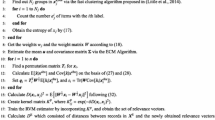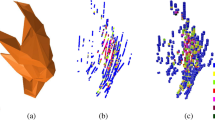Abstract
Due to the geological complexities of ore body formation and limited borehole sampling, this paper proposes a robust weighted least square support vector machine (LS-SVM) regression model to solve the ore grade estimation for a seafloor hydrothermal sulphide deposit in Solwara 1, which consists of a large proportion of incomplete samples without ore types and grade values. The standard LS-SVM classification model is applied to identify the ore type for each incomplete sample. Then, a weighted K-nearest neighbor (WKNN) algorithm is proposed to interpolate the missing values. Prior to modeling, the particle swarm optimization (PSO) algorithm is used to obtain an appropriate splitting for the training and test data sets so as to eliminate the large discrepancies caused by random division. Coupled simulated annealing (CSA) and grid search using 10-fold cross validation techniques are adopted to determine the optimal tuning parameters in the LS-SVM models. The effectiveness of the proposed model by comparing with other well-known techniques such as inverse distance weight (IDW), ordinary kriging (OK), and back propagation (BP) neural network is demonstrated. The experimental results show that the robust weighted LS-SVM outperforms the other methods, and has strong predictive and generalization ability.
Similar content being viewed by others
References
Chatterjee S, Bandopadhyay S, Rai P. 2008. Genetic algorithm-based neural network learning parameter selection for ore grade evaluation of limestone deposit. Mining Technology, 117(4): 178–190
Garcia-Laencina P J, Sancho-Gomez J L, Figueiras-Vidal A R. 2010. Pattern classification with missing data: a review. Neural Computing & Applications, 19(2): 263–282
Gencoglu M T, Uyar M. 2009. Prediction of flashover voltage of insulators using least squares support vector machines. Expert Systems with Applications, 36(7): 10789–10798
Herzig P M, Hannington M D. 1995. Polymetallic massive sulfides at the modern seafloor: a review. Ore Geology Reviews, 10: 95–115
Huang W B. 2011. Using tuned LS-SVR to derive normal height from GPS height. Proceedings of the 2011 IEEE International Conference on Spatial Data Mining and Geographical Knowledge Services (ICSDM2011). NJ, USA: Piscataway, 511–514
Jerez J M, Molina I, Garcia-Laencina P J, et al. 2010. Missing data imputation using statistical and machine learning methods in a real breast cancer problem. Artificial Intelligence in Medicine, 50(2): 105–115
Kanevski M, Pozdnoukhov A, Timonin V. 2009. Machine learning for spatial environmental data theory, application and software. Lausanne, Switzerland: EPFL Press
Kennedy J E, Eberhart R C. 1995. Particle swarm optimization. Proceedings of IEEE International Conference on Neural Networks. NJ, USA: Piscataway, 1942–1948
Kennedy J E, Eberhart R C. 1997. A discrete binary version of the particle swarm optimization. IEEE International Conference on Systems, Man, and Cybernetics, 5: 4104–4105
Little R J A, Rubin D B. 2002. Statistical Analysis with Missing Data. Hoboken, New Jersey: JohnWiley & Sons Inc
Lipton I. 2008. Mineral resource estimate Solwara 1 project Bismarck Sea Papua New Guinea for Nautilus Minerals Inc, Canadian NI43-101 form F1. http://www.nautilusminerals.com/i/pdf/2008-02-01_Solwara1_43-101.pdf/2008-02-01/2011-06-15
Mahmoudabadi H, Izadi M, Menhaj M B. 2009. A hybrid method for grade estimation using genetic algorithm and neural networks. Computational Geosciences, 13(1): 91–101
Samanta B. 2010. Radial basis function network for ore grade estimation. Natural Resources Research, 19(2): 91–102
Samanta B, Bandopadhyay S. 2009. Construction of a radial basis function network using an evolutionary algorithm for grade estimation in a placer gold deposit. Computers & Geosciences, 35(8): 1592–1602
Samanta B, Bandopadhyay S, Ganguli R, et al. 2002. Data segmentation and genetic algorithms for sparse data division in nome placer gold grade estimation using neural network and geostatistics. Mining Explor Geol, 11(1–4): 69–76
Suykens J A K, De Brabanter J, Lukas L, et al. 2002. Weighted least squares support vector machines: robustness and sparse approximation. Neurocomputing, Special issue on fundamental and information processing aspects of neurocomputing, 48(1–4): 85–105
Suykens J A K, Lukas L, Van Dooren P, et al. 1999. Least squares support vector machine classifiers: a large scale algorithm. Proc European Conf on Circuit Theroy and Design (ECCTD’99). Torino, Italy: Politecnico di Torino, 839–842
Suykens J A K, Lukas L, Vandewalle J. 2000. Sparse approximation using least squares support vector machines. IEEE International Symposium on Circuits and Systems ISCAS’2000. Lausanne, Switzerland: Presses Polytechniques et Universitaires Romandes, 757–760
Suykens J A K, Vandewalle J. 1999. Least squares support vector machine classifiers. Neural Processing Letters, 9(3): 293–300
Van Gestel T, Suykens J A K, Baesens B, et al. 2004. Benchmarking least squares support vector machine classifiers. Machine Learning, 54(1): 5–32
Van Gestel T, Suykens J A K, Lanckriet G, et al. 2002. Multiclass LSSVMs: moderated outputs and coding-decoding schemes. Neural Processing Letters, 15(1): 45–58
Vapnik V N. 1998. Statistical Learning Theory. New York: John Wiley
Xavier de Souza S, Suykens J A K. 2010. Coupled simulated annealing. IEEE transactions on Systems, Man, and Cybernetics, Part B, 40(2): 320–335
Yama B R, Lineberry G T. 1999. Artificial neural network application for a predictive task in mining. Mining Eng, 51(2): 59–64
Author information
Authors and Affiliations
Corresponding author
Additional information
Foundation item: Project of China Ocean Association under contact No. DYXM-125-25-02; Independent Research Project of Tsinghua University under contact Nos 2010THZ07002 and 2011THZ07132.
Rights and permissions
About this article
Cite this article
Zhang, X., Song, S., Li, J. et al. Robust LS-SVM regression for ore grade estimation in a seafloor hydrothermal sulphide deposit. Acta Oceanol. Sin. 32, 16–25 (2013). https://doi.org/10.1007/s13131-013-0337-x
Received:
Accepted:
Published:
Issue Date:
DOI: https://doi.org/10.1007/s13131-013-0337-x




